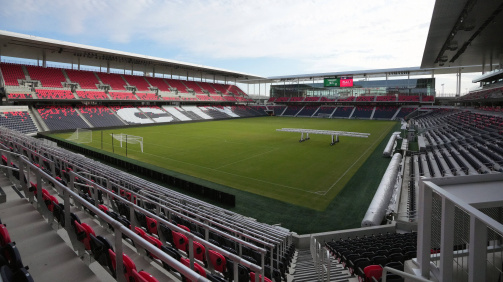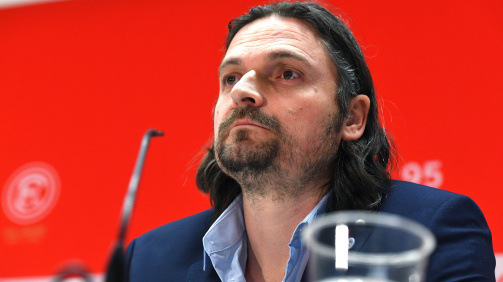Ahead of the 2023 season
How do you build a squad from scratch, or rather, how do you build an entire club? Perhaps the only league that offers some insight into that process is Major League Soccer, a league in which clubs are designed on a blank canvas. The latest example is expansion side St. Louis CITY SC. Based in Missouri, the 29th MLS club will kick off its inaugural season this February.
Awarded an expansion franchise in 2019, the club was initially supposed to kick off in 2022, but because of the COVID-19 pandemic, the launch of the new club was delayed by one year. “This will give me more time,” Lutz Pfannenstiel said to Transfermarkt in August 2020 shortly after he was revealed as the new sporting director of the club. Signed that spring to guide the club to MLS, the world-famous German globetrotter is one of the main protagonists of this story.
The response was also typical of the 49-year-old, who took the job in St. Louis after rejecting offers from several European top clubs. Rather than seeing the delay as a negative, Pfannenstiel saw an opportunity—extra time to get the project right, to build something extraordinary in one of America’s most historical soccer cities.
Mercedes-Benz Stadium, Lumen Field & Co. – All 29 MLS Stadiums at a glance
St. Louis: America’s original soccer city
Because, make no mistake, in the context of US soccer history, St. Louis matters. St. Louis is America’s first-ever soccer capital. The sport has been played in the city since 1875 and, according to MLSSoccer.com, has produced 91 national championships on various levels (US Open Cup; Amateur and U-19 Cups; and NCAA, NAIA, and NJCAA titles), 31 members of various national soccer halls of fame, and developed 61 US national team players.
St. Louis also produced five players that went to the 1950 World Cup in Brazil, where the US men’s national team famously beat England (1-0). The city also produced several notable US players, including Pat Noonan, Brad Davis, Steve Ralston, Taylor Twellman, Tim Ream, Will Bruin, and Josh Sargent.
Another notable name is the Bosnian striker Vedad Ibišević. Born in Vlasenica, Yugoslavia, Ibišević’s family escaped the conflict in the Balkans and settled among the large Balkan community that calls St. Louis its home. The striker would play his formative years at Roosevelt High School and then in college for the St. Louis Billikens before a prolific Bundesliga career.
St. Louis: Rich soccer history but no professional club
St. Louis has the soccer history nailed down. What the city lacked in recent decades was a first-division team. There were, of course, the St. Louis Stars, who played in the North American Soccer League (NASL) between 1967 and 1977. The Stars moved to California in 1978 to become the Surf, and the NASL would fold seven years later. Various pro teams have played in St. Louis since, including St. Louis FC in the USL Championship.
With the history in mind, it is perhaps somewhat surprising that MLS took until 2019 to expand to the city. But more than 25 years after the league was founded, MLS has started to become a significant business. St. Louis had to pay a $200 million expansion fee to enter the league. That fee was paid to acquire the license to play in the league and did not involve the construction cost of a stadium, the training facility, and signing players.
Those costs are all separate, and St. Louis, thanks to the help of Carolyn Kindle, the president of the Enterprise Holdings Foundation. Although Enterprise is the largest car rental agency on the planet, with a seat in St. Louis and an annual revenue of $30 billion, the expansion fee and the investment in the city’s soccer infrastructure is considered a major outlay. But the investors are deeply rooted in the city and wanted to give back to the community.
St. Louis CITY SC: A billion-dollar investment
The same can be said about the stadium. Built for around $450 million, the CITYPARK Stadium is a fantastic soccer-specific stadium set in the heart of St. Louis. But ownership did not stop at the expansion fee and the stadium.

St. Louis CITYPARK Stadium is located right downtown
Located next to CITYPARK is the brand-new training complex that would be the envy of most top teams in Europe. Transfermarkt visited both the stadium and got a tour of the training facility this winter ahead of the opening match against Bundesliga side Bayer Leverkusen (0-3). The work and detail that has gone into the facility by the ownership group, sporting director Pfannenstiel, his consultant Bernhard Peters—one of the key architects of Bundesliga side Hoffenheim—and the entire team is impressive.
One of the first things that stand out when you arrive at the St. Louis City SC HQ located on Pine Street is the proximity to the stadium. From the first team to the academy, the players train right in the shadow of CITYPARK. In fact, you can pretty much walk off the training field down a tunnel into the bowels of the stadium.
St. Louis CITY SC: Community oriented with a university flair
“It is important to have the players see what they are playing for,” Pfannenstiel said. “Whether it is an academy player, someone playing for the MLS Next Pro side, or the first team. Having the stadium right there, in proximity, reminds them of their goal. It is a great motivator during any training session.”
The entire complex is almost constructed like a university campus. Not only is the stadium and the training facility right downtown near one another, even the flagship fan store, for example, is located right between the two. Then, right behind the stadium is the city’s favorite brewery Schlafly, which, hosted a tailgate party ahead of the Leverkusen game. The stadium itself has community facilities—called the Lou Fusz Plaza—that fans can use, and the food stalls are manned by local favorites.
It is in the training complex, however, where one gets a true sense of the details that have gone into building the club. A few things stood out. The analytical staff is on the second floor with a good view of the training pitches. All offices have transparent walls, giving one a sense of openness, and encouraging the different departments to work closely together.
Infrastructure: Sporting director Pfannenstiel was inspired by Guardiola
Those details continue on the first floor, where the dressing rooms of the academy and the first team are located. While the academy and MLS Next Pro dressing rooms are austere, the dressing room of the first team dressing room is oval, an idea inspired by Man City manager Pep Guardiola, which can be seen in the Amazon Prime documentary. The design makes the room feel like a lecture hall of a top-class university.
Training pitch sights and sounds pic.twitter.com/WYAzqnkVwz
— St Louis CITY SC (@stlCITYsc) January 11, 2023
There are elements that make it all feel like a football research institute. This is further underlined by the fact that the club has brought in some of the newest technology, including a cryo-chamber. Used for recovery, Pfannenstiel becomes visibly excited when he shows off the technology, using this Transfermarkt writer as a test subject.
Having survived the cryo-chamber, Transfermarkt is then shown the workout room, where Pfannenstiel has borrowed another Guardiola innovation. Located level with the first team’s training fields, the weight room includes a garage-style door that can be opened in the summer to allow staff and players to move equipment onto the field turning it into a massive outdoor gym.
Pfannenstiel on St. Louis City SC: “Owner spared no expense”
“The ownership spared no expense,” Pfannenstiel said. There is no doubt that the club spent big on infrastructure and the stadium. The entire bill is easily in the range of $1 billion. The backing of a wealthy owner indeed allows the club to spend more than most clubs playing in a top-four league in Europe and, at first glance, seems excessive. But given the club’s location right downtown, St. Louis only have one chance to get the foundation right, and although expensive, the club will be ahead of the competition for decades.
Regarding infrastructure, St. Louis CITY SC have gone all out under Pfannenstiel. But when it comes to building a team, Pfannenstiel has a very different approach. “We want to stay away from older big names PR type of moves,” Pfannenstiel said in an interview with Transfermarkt one year ago. “We will need to have fit players for the style of football we want to play. It would be counterproductive for us to have a big name who played his own game. Instead, we need to look at this club’s long-term structure and long-term success.”

Sporting director Lutz Pfannenstiel joined St. Louis CITY SC from Fortuna Düsseldorf despite having offers from several European top clubs
With the roster taking shape, there is undoubtedly a sense that Pfannenstiel has kept his word. With the squad assembled mainly by the time of writing, St. Louis CITY SC have paid just €5.23m in transfer fees to put together a team with an overall market value of €17.03m. That overall squad value might put St. Louis last in MLS for now, but two factors are important to keep in mind.
Njabulo Blom: South African plays a bit like Tyler Adams
First of all, the squad is not a finished product at this stage, and the market value will likely change with the first update of the season in early March. Second, Pfannenstiel, his new head coach Bradley Carnell and the entire club staff, for the most part, have gone after players who they believe could soon increase their market value. The idea is to make the club sustainable, sign players, and move them on with a profit.
In that regard, two players, in particular, stand out. Tomas Ostrak, signed on a free transfer from Bundesliga side Köln, was wanted by several German clubs. With a market value of just €750,000, the 22-year-old Czech youth national team player is already considered one of the biggest talents in MLS. Another top signing is South African midfielder Njabulo Blom.
Blom was signed for around €300,000 from South African side Kaizer Chiefs. Projected to be a similar player to US men’s national team captain Tyler Adams, Blom was available for below market value because his contract was set to expire, and the Kaizer Chiefs’ management was worried they could lose the player to a direct competitor. Pfannenstiel and his South African head coach Carnell were aware of this situation and quickly struck a deal and then convinced Blom to head to MLS before going to Europe.
Ostrak, Blom and Pidro: Pfannenstiel beat out European competition
Ostrak and Blom are the most obvious candidates when it comes to significant upside on the transfer market. But there are also other candidates. Bosnian left-back Selmir Pidro (signed from FK Sarajevo) and Danish winger Isak Jensen (signed from SönderjyskE)—he has been described as an Angel di María type of player—are two more players with potentially huge upside. The 19-year-old Jensen had interest from several clubs, including Bayern Munich and Olympique Lyon.
Players with veteran experience anchor the younger European players. First and foremost, Roman Bürki. The former Swiss international arrived from Borussia Dortmund and turned down offers from Turkish clubs, Valencia and Bayern, where he would have been the backup to Manuel Neuer, to join St. Louis CITY SC. Building from the back will be an important aspect of a side that will be playing a high-powered Red Bull-powered type of football under Carnell.
Then there is Brazilian forward João Klauss, who Pfannenstiel initially scouted while heading up Hoffenheim’s scouting department back in 2017. Klauss may have never broken into Hoffenheim’s first team, but they had good goalscoring records in Finland and Austria. The 25-year-old will compete with US striker Nicholas Gioacchini, who the club secured in the expansion draft from Orlando City. Gioacchini will provide both European and MLS experience to the squad.
From Nilsson to Blom: St. Louis CITY SC top 10 sorted by market value
St. Louis CITY SC playing style: A bit like Julian Nagelsmann
“MLS is going to be a good league for me,” Klauss said in an interview with TM last summer. “Because it is very physical, and you are forced into many duels, which is very good for me. Also, the way the team wants to play, I have played like that before. I know the system, and it makes me very excited.”
All those pieces will be significant for Carnell to play a high-press attacking style like what Hoffenheim and RB Leipzig played under protégée head coach Julian Nagelsmann. “It is going to be intense and a very transitional style of play with a front foot approach; we want to press and counter-press,” Carnell said when he was officially introduced by St. Louis CITY SC last spring. “That sort of play is very fashionable, of course, but I have lived it, played it, and been coached it. It is a style of play that will speak to the community in the Mid-West, hard work and humility.”
Carnell provided further detail when he spoke to Transfermarkt last summer when St. Louis CITY SC 2 played Whitecaps 2 in the MLS Next Pro. Speed is at the core of that playing style, with Klauss or another center-forward as the target-man, allowing fast players to rush up the field, creating chaotic moments and room to score goals.
MLS Next Pro allowed St. Louis CITY SC to experiment
It is a demanding style, but when MLS announced that they would delay the club’s expansion by one year, St. Louis CITY SC opted to field a team in MLS Next Pro instead, using that competition as a laboratory for the 2023 MLS season. Coached by John Hackworth, the side had the luxury of having Bürki, Ostrak, and Co. available at some point of the season—some of the European players played four games each.
That side was, however, also important to scout and trial local talent. In fact, finding and developing local talent is another important core element for the club. The likes of Joshua Yaro and Canadian center-back Kyle Hiebert, for example, played their way to MLS contracts using the MLS Next Pro experience. The same can be said for Brazilian Célio Pompeu and German midfielder Max Schneider.
Then there are the highly talented Anthony Faupel and Miguel Perez. Both remain on the first team’s radar and are currently training with the academy. Pfannenstiel and director of team operations Vin Ko found both players on their endless scouting trips through Missouri.
Vin Kon on scouting players in Missouri: “Trips were interesting
“Some of those trips were very interesting,” technical director Vin Ko said to Transfermarkt. “We found those guys in small high schools, city parks, some in the middle of nowhere playing on soccer pitches, sometimes hidden by cornfields. People must have thought we were weird showing up watching random soccer games in the countryside.” Pfannenstiel laughs while Ko tells the story at the St. Louis HQ, indicating that while strange, they did enjoy their trips through the hinterlands of America’s Midwest.
Both stressed the fact that they believe that the region has been heavily under-scouted and that they want St. Louis to be at the core of finding and developing talent. Talent development can then be described as another pillar of the MLS’s latest soccer club.
Many clubs, of course, describe talent development as one of their core principles. But St. Louis highlighted already that they are serious. On Jan. 9, they signed 15-year-old Caden Glover to a five-year homegrown contract. Glover is already a youth international and considered one of the brightest prospects in the country, born in 2007. “Considering that he is only 15, Caden is already an exceptional talent with plenty of big European clubs showing interest,” Pfannenstiel said to Transfermarkt. “But there is plenty of more local St. Louis talent out there; in fact, we are absolutely privileged with the number of talents in our region, and it is important to us that the club is strongly rooted in the community.”
Our FIRST-EVER Homegrown!
We have signed 15-year-old United States youth international center forward and STL CITY Academy product Caden Glover to a five-year MLS deal.
— St Louis CITY SC (@stlCITYsc) January 9, 2023
St. Louis CITY SC: No matter the results, the foundation is firmly in place
The training facility, the stadium, the squad, and the academy—all firmly rooted in the city’s community. It all seems to come together very nicely in St. Louis. Of course, we will not know whether the team will be a success from the start. Apart from LAFC and Atlanta United, very few expansion teams were title challengers from the start. And with the squad still being put together, it will be interesting to see how St. Louis CITY SC will perform in their first-ever MLS game on Feb. 25 on the road against Austin FC.
Ultimately, the truth will be on the pitch. But even if it takes a couple of seasons, there is no doubt that Pfannenstiel and his team, with the help of the ownership group, have laid a strong foundation for St. Louis CITY SC to be successful for many years to come. The stadium and training complex is world-class, and the club already has a functioning academy, and signed talent that, on paper, provides a good mix in what is one of the fastest-growing leagues in the world.
Homepage

